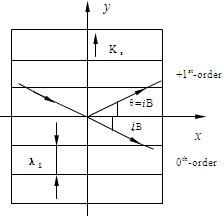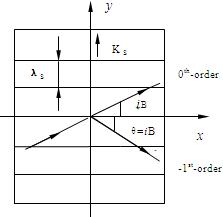

Schematic of Bragg diffraction
Note: oscilloscope not included
Features
Easy operation
Precise measurement
Stable base
Acousto-optic modulation technique demo
Introduction
The LEOI-33 Experimental System for Acousto-Optic Effect is designed to help students explore the interaction between sound waves and light, also known as the acousto-optic effect. This phenomenon occurs when the refractive index of a medium changes due to the presence of sound waves, which creates a refractive index grating that can diffract light. The acousto-optic effect enables control over various properties of light, including its frequency, direction, and intensity. This effect is widely used in devices such as acousto-optic modulators, deflectors, and filters, and plays an essential role in areas like laser technology, optical signal processing, and integrated optical communication.
The system allows for the demonstration of key principles of the acousto-optic effect and provides hands-on experience in measuring and analyzing the parameters associated with this phenomenon.
Using this system, the following experiments can be conducted:
1. Bragg Diffraction Observation: Students can observe the phenomenon of Bragg diffraction caused by sound waves and measure the Bragg diffraction angle, which relates the angle of incidence of light to the sound wave's frequency.
2. Acousto-Optic Modulation Waveform Display: The system allows students to view and analyze the acousto-optic modulation waveform, demonstrating how light can be modulated using sound waves.
3. Acousto-Optic Deflection Observation: The system demonstrates the acousto-optic deflection phenomenon, where light is deflected from its original path due to the sound waves in the medium.
4. Measurement of Acousto-Optic Modulation Amplitude: Students can measure the amplitude of the light's intensity modulation caused by sound waves, allowing them to understand the relationship between sound wave strength and optical modulation.
5. Measurement of Diffraction Efficiency and Bandwidth: The system enables precise measurement of acousto-optic diffraction efficiency and bandwidth, essential parameters for the performance of acousto-optic devices.
6. Measurement of Ultrasound Wave Velocity: Students can measure the traveling velocity of ultrasound waves in the medium, a critical factor in designing and optimizing acousto-optic devices.
7. Simulate Optical Communication: The system provides a platform for simulating optical communication using acousto-optic modulation techniques, allowing students to understand how light is modulated for data transmission.
The instruction manual contains comprehensive materials including experimental configurations, principles and step-by-step instructions. Please click Experiment Theory and Contents to find more information about this apparatus.
Specifications
| Description | Specifications |
| Ultrasound Signal Frequency | 100 MHz |
| He-Ne Laser Output | >2.0 mW @632.8 nm |
Acousto-Optic Crystal | Working Wavelength: 633 nm |
| Center Frequency: 100 MHz | |
| Effective Aperture: 1 mm | |
| Transmissivity: >96% | |
| Bragg Angle: 17.4 mrad | |
| Polarization of Input Light: Any | |
| Internal Modulation Signal | 1 kHz |
Part List
| Description | Qty |
| Main control unit | 1 |
| He-Ne laser with power supply | 1 set |
| Laser tube holder | 1 |
| Acousto-optic modulator | 1 |
| Acousto-optic modulator holder | 1 |
| Optical rail | 1 |
| General carrier | 1 |
| X-translation carrier | 1 |
| Transverse measurement holder | 1 |
| Photoreceiver | 1 |
| Speaker with AC adaptor | 1 set |
| Cables | 4 |
| Manual | 1 |


Schematic of Bragg diffraction